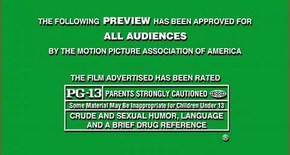 The MPAA, smugly caught with their pants down and forcibly man-handled by Kirby Dick and This Film Is Not Yet Rated, is in the process of attempting to more clearly explain ratings decisions. Of course, Dan Glickman (Jack Valenti’s replacement) has stated this move was well under way before Dick exposed MPAA foolishness. Because, you know, corporate types are never, ever reactionary- they’re always on top of it.
The MPAA, smugly caught with their pants down and forcibly man-handled by Kirby Dick and This Film Is Not Yet Rated, is in the process of attempting to more clearly explain ratings decisions. Of course, Dan Glickman (Jack Valenti’s replacement) has stated this move was well under way before Dick exposed MPAA foolishness. Because, you know, corporate types are never, ever reactionary- they’re always on top of it.
Within the MPAA’s proposed restructuring (to be announced at the official Sundance opening on Monday), the usual promises abound. More clarification. Better outreach programs. Transparency. Yes, more generalities defined by generalities.
Wading through all the corporate speak, there are a few salient changes for the common folk: explanation of exactly what standards must be met to qualify for a rating/appeal, the (meaningless) posting of the ratings board members demographics, the actual website posting of senior rating members names, raters will be formally trained (meaning… what?) and members of the ratings board will have their God-privileges revoked once their children are grown.
Filmmakers benefit in what initially sounds like a positive- when appealing a rating decision, filmmakers can finally cite other films. Ultimately, however, the allowance is simply a wash. The decision of content is still a caveat centered on the subjective context decision of the board. In a second yet-to-be-determined "positive", if a film goes to the appeals board, the board will receive an infusion of additional members not on the MPAA or North American Theater Owners payroll. Still, despite this promise of "new blood", ultimately they’re picked by the same governing bodies who stocked the review board in the first place.
MPAA and NATO have also introduced a Red Carpet Ratings service, which will email parents (who care enough to sign up at the website*) a weekly summary of new release ratings. I subscribed to the update, and it’s nothing different than what you can see on posters or TV spots– mostly meaningless generalities.
The description system is one of the core problems with the MPAA ratings system. Rating a film on "language", when the same descriptor comes up in R, PG-13 and PG means nothing. Similarly, what is the MPAA’s subjective definition of a "thematic issue"? "Sexuality"? "Some violence"? "Brutality"? How does that match up with the definitions of everyone else?
In one of the more apt descriptions out of the MPAA, Saw 3 was given an R for "strong grisly violence and gore, sequences of terror and torture, nudity and language." Barring the whole language thing, that classification seems descriptive enough. Yet, Hostel has plenty of nudity and girl-on-top antics, yet is rated "strong sexual content". So what is "sexual content"? How is that defined? Why not "Sexual Intercourse"? Many Americans would consider sexual content to be a fully clothed couple making out in the shower. Ridiculous yeah, but that’s the problem with the classifications- they’re just not definitive. Violence and "thematic elements" get the same treatment.
Any change to the ratings system and how it’s administered is welcome. I’ll step out on a limb and say, in their purest form ratings are a useful tool for everyone. What ratings shouldn’t be is a device used to railroad films from wide release, manipulate a film into wide release or become so subjective without explanation as to be meaningless for any segment of movie-goer. Unfortunately, "fixes" forthcoming, the scale is still tilted far too close the latter.
*A messy, busy pile of turd.